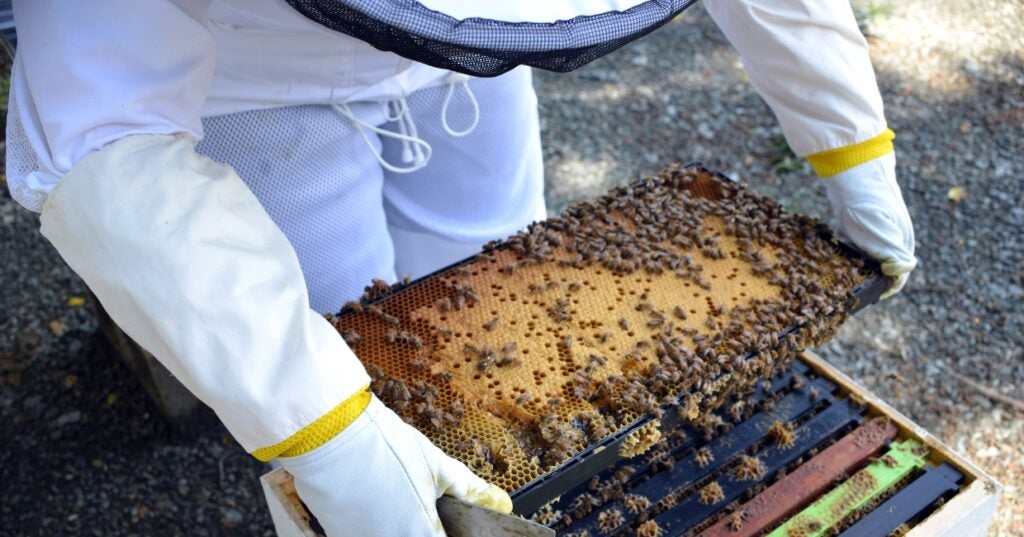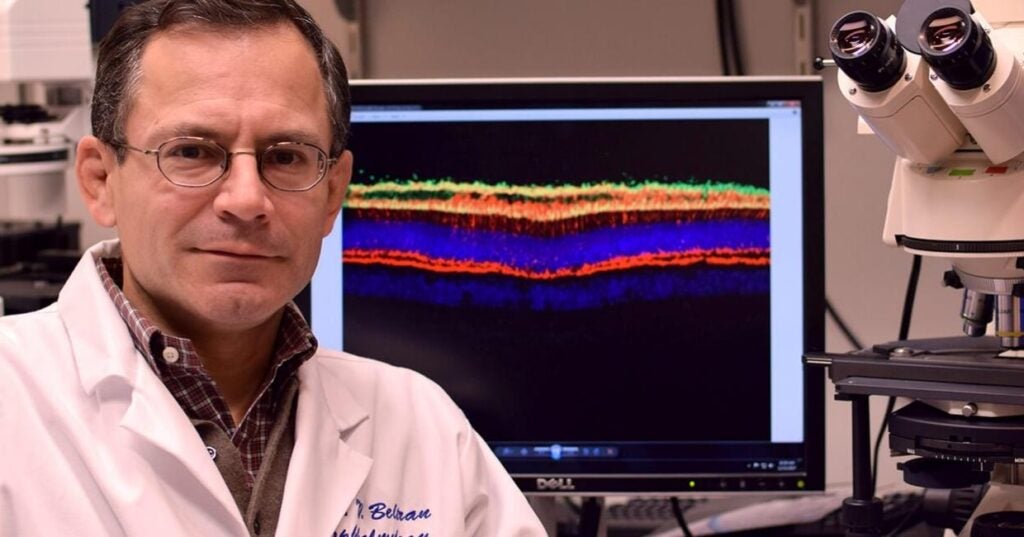Penn Vet Teamwork Comes Through for a Dog with a Strong Will but a Sick Heart

Something about Litte Dove just wasn’t quite right.
Even in her favorite Philly park with her favorite people, the usually plucky shepherd mix sat down abruptly in mid-walk.
“Come on, Little,” coaxed Elizabeth Mauldin, the Penn Vet dermapathologist who’s owned the midnight-coated rescue since she was a pup. And Little Dove did come toddling along, only to stop again. Not panting. She simply sat. She could have been tired; eight years old, Little Dove was in a clinical trial for arthritis. So Mauldin and her partner James Szymanski took their dog home. She slept a lot. But later that evening, she began vomiting.
Concerned, Mauldin had already decided to bring Little Dove to work to get her checked out. The dog was still sluggish. Blood tests that came back that afternoon showed some nagging liver and kidney readings. Mauldin asked her colleague and friend Mary Beth Callan, a senior Penn Vet internist, to take a look.
“I saw the dog on the office floor looking quite flat, so I felt the legs,” Callan recalled. “They were cold.”
“Beth said, ‘Elizabeth, I think we need to look a little more carefully at your dog.”
So down to a third-floor ward examining room they went.
By then, it was late afternoon, a time when Penn Vet’s Matthew J. Ryan Veterinary Hospital was already quite busy and its staff was pressed by many other demands. What was about to transpire encompassed every animal lover’s greatest fear and most fervent hope: a health emergency that threatened to end their pet’s life and veterinary professionals with the skills to save it.
Little Dove could have died. That she did not is a testament to the abilities of a group of veterinary professionals that spanned a broad range of specialties – internal medicine, radiology, cardiology, nursing, emergency services, infectious disease. Some senior clinicians, others still early in their careers, they all rose to meet a perplexing, rapidly unfolding challenge with clear-eyed judgment.
Mauldin, who’d treated many ill animals in her own career, was well acquainted with her colleagues’ expertise. But it’s not every day that a clinician gets to be on the receiving end.
“The word is ‘grateful,’” she said. “And ‘impressed.’”
Had Little been someone else’s dog, that team would have rallied as well, but to Mauldin that is precisely the point.
“This happens all the time, but it was my dog and I was there. It was realizing the skill and the teamwork,” she said. “It was just amazing.”
Troubling symptoms but no clear cause
Initially, Mauldin thought Little Dove might have been having an adverse reaction to a medication she was on from the arthritis trial. But after consulting with one of the trial’s doctors, she learned Little Dove was one of the dogs on a placebo. The worrisome symptoms had to be coming from something else.
As Callan examined Little Dove, she saw more cause for concern, although still no obvious cause.
Using two separate thermometers to double-check Little’s temperature, she found it below normal – 97 and 96.5 degrees, instead of in the 100 to 102 degrees range.
That wasn’t all.
“Her heart rate was 160 which is really high for a dog. Normal is around 80 to 120 depending on the dog, and we were unable to get a blood pressure on her,” Mauldin said.
Callan went to radiology to inquire about getting an ultrasound. “She was worried she might have pancreatitis, something internally wrong with her,” Mauldin said.
At that hour, radiology was quite busy. But Maria Mulvihill, who had completed her residency and was working that afternoon, agreed to take a look at Little Dove.
“She found fluid in the abdomen but couldn’t really find a reason for it in the abdomen. So she put her probe up to the chest,” Callan said. “Suddenly you could see the heart was not effectively contracting.”
Elizabeth Snyder, a third-year internal medicine resident, was working a radiology rotation that week. She saw it, too.
“It was kind of just like quivering,” Snyder said. “That was very abnormal.”
So Snyder, who’d worked a year in the emergency room of Philadelphia Animal Specialty and Emergency before returning Penn Vet to do her residency, rushed off to fetch an electrocardiogram machine that would show the electrical conduction of the heart, including heart rate, rhythm and waveform.
She hooked Little up. The pattern on the screen went wild.
“I think I’m going to faint,” Mauldin remembers saying.
The culprit was Little Dove’s heart, after all. The dog was in ventricular tachycardia – a very dangerous and very fast heart rhythm. Her heart rate had climbed to over 300 – well over the already-too-fast 160 it was a mere half hour before. Another dog wouldn’t even have been awake at that point – an unusual presentation that probably made the dog’s heart less likely to be suspected. Somehow stoic Little Dove was still with them, but barely.
“I was very close to losing her,” Mauldin said.
And then everything happened very fast.
With the help of emergency room nursing staff, Snyder placed an intravenous catheter in Little Dove so she could administer a dose of lidocaine. The hope: restore a normal heart rate. But first she put in a consult call to her good friend Victoria Convey, a Penn Vet cardiology resident. Convey, who had just gotten home from work, had already heard about Little’s plight from the hospital’s internal messaging system when Snyder reached her.
“It was a very severe arrhythmia,” she said. “It was kind of nerve-wracking because I think Dr. Mauldin was there in the background, so I didn’t want to say anything that sounded super alarming. I just confirmed, ‘You should give her a dose of lidocaine,’ which would be our first line of treatment for that.’ Then I said, ‘Okay, I’m going to come back in.”
The lidocaine worked. Little Dove’s heart rate quickly returned to a safe rate. Convey arrived back at the hospital to help with the next leg of her care that evening.
Continuing care for Little Dove, hopeful signs, and gratitude for her team
Little Dove still wasn’t out of the woods. During her overnight stay at Ryan, she had another tachycardia episode. The next day, she was able to return home. A week later, she began exhibiting some of the same symptoms, so Mauldin brought her into the emergency room. She was stabilized and sent home.
Little Dove was diagnosed with myocarditis, inflammation of the heart muscle. Her heart had been damaged in some way, but the underlying cause has not been confirmed, possibly a vector-borne ailment, according to her owner. The dog is being monitored and treated with several medications.
Little Dove, meanwhile, has her old appetite back which is always a good sign. She’s not back to doing zoomies, and she is sleeping more than she used to, Mauldin said. But she’s enjoying her walks, her dog friends, and her people.
“There are times she’s stopped eating and appeared a little lethargic, but she’s bounced back.”
Her owner is quite thankful to the teamwork that helped make that possible.
“I have a dog that should be dead, and she walked home the next day. So far, she’s a month out and is doing pretty well,” Mauldin said. “If she’d been anywhere else, I don’t think she’d be here today.”
Related News

Researchers Advance mRNA Delivery to the Retina Using Stabilized Lipid Carriers
Efficient delivery of synthetic mRNA to the retina remains one of the key hurdles in developing mRNA-based treatments for vision loss.

A New Penn Vet Study Aims to Shed Light on Honeybees’ Foraging Habits, with an Eye Toward Aiding their Survival
A new study recently underway at the University of Pennsylvania School of Veterinary Medicine’s (Penn Vet) New Bolton Center, led by Associate Professor of Epidemiology Laurel Redding, aims to shed…

Penn Vet Researchers Evaluate a New Device That Could Streamline Vision-Saving Therapies
Retinal blindness caused by the death of photoreceptors, the light-sensing cells within the retina, affects millions of people worldwide. Novel gene and cell therapies to prevent or rescue vision loss…
About Penn Vet
Ranked among the top ten veterinary schools worldwide, the University of Pennsylvania School of Veterinary Medicine (Penn Vet) is a global leader in veterinary education, research, and clinical care. Founded in 1884, Penn Vet is the first veterinary school developed in association with a medical school. The school is a proud member of the One Health initiative, linking human, animal, and environmental health.
Penn Vet serves a diverse population of animals at its two campuses, which include extensive diagnostic and research laboratories. Ryan Hospital in Philadelphia provides care for dogs, cats, and other domestic/companion animals, handling more than 34,600 patient visits a year. New Bolton Center, Penn Vet’s large-animal hospital on nearly 700 acres in rural Kennett Square, PA, cares for horses and livestock/farm animals. The hospital handles more than 6,200 patient visits a year, while our Field Services have gone out on more than 5,500 farm service calls, treating some 18,700 patients at local farms. In addition, New Bolton Center’s campus includes a swine center, working dairy, and poultry unit that provide valuable research for the agriculture industry.

